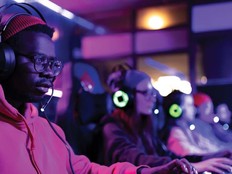College Hackathon Designers Tackle Accessibility Challenges
Given the 11-hour timeframe, the founders of the Assistive Technology Hackathon don’t expect participants to produce usable products by the end of the event, says Jaya Narain, a doctoral student at MIT who helped launch ATHack as an undergrad. But because participants — who may be students, designers or community members — first meet at a dinner two weeks beforehand, many arrive at the event ready to go. The annual hackathon pairs students with individuals who have disabilities to create innovative, technology-based solutions for their challenges.
Approximately 75 students worked on 15 projects at this year’s ATHack, held March 3 at the MIT Lincoln Laboratory Beaver Works Center in Cambridge, Mass. By the end of the event, eight or nine of those projects were complete, says Narain.
“The main goal of the hackathon is really to introduce students to the design process and build connections between community members and students,” Narain says. “But we’ve actually had a lot of projects that have been successful just within the span of the hackathon.”
SIGN UP: Get more news from the EdTech newsletter in your inbox every two weeks!
ATHack Site Shares Design Solutions
This year’s winner of the Functionality Prize was a wearable armband that vibrates to alert a person with impaired hearing that the doorbell is ringing. A portable chair device, created to help an individual comfortably use a shower when traveling, nabbed a Co-Designer Collaboration Prize.
Some participants choose to share their designs online for others to replicate. One group, which created a device that allows a co-designer with cochlear implants to use wired and wireless earbuds, published its work on the DIY Instructables platform.
Along the same lines, ATHack organizers have compiled a database of hackathon projects, which they hope to share online in the next few months.
“After every event, we’ve added all the projects to the website. It’s usually just a short description,” Narain says. “We asked teams this year to submit sketches of what they were working on. We’re compiling it in a way for someone else who has a similar challenge to use.”
From Brainstorm to Business Product
In the five years since the ATHack began, more than 300 participants have worked on upwards of 70 projects. At least one has led to a business launch: Massachusetts-based tech startup Puffin Innovations, founded by 2015 ATHack participants who developed a portable Bluetooth joystick mouse to provide smart device access in mobile settings.
For some students, ATHack is their first opportunity to get direct feedback about what part of a design is useful or needs improvement. In addition to giving students a chance to use their skills and share their work, the event also yields another significant benefit, says Narain.
“Co-designers have ideas and projects they’re excited about, whether it’s a way to do a hobby or something to help them go about day-to-day life,” she says. “You’re working closely with that person. You get a better understanding of the challenges they may be faced with. That experience can be really eye-opening.”








